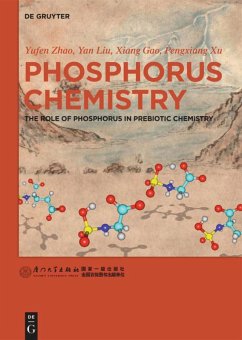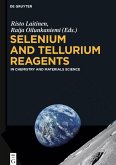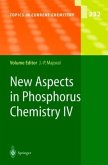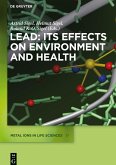Yufen Zhao, Yan Liu, Xiang GaoThe Role of Phosphorus in Prebiotic Chemistry
Phosphorus Chemistry
The Role of Phosphorus in Prebiotic Chemistry
Mitarbeit:Xiamen University Press
Yufen Zhao, Yan Liu, Xiang GaoThe Role of Phosphorus in Prebiotic Chemistry
Phosphorus Chemistry
The Role of Phosphorus in Prebiotic Chemistry
Mitarbeit:Xiamen University Press
- Gebundenes Buch
- Merkliste
- Auf die Merkliste
- Bewerten Bewerten
- Teilen
- Produkt teilen
- Produkterinnerung
- Produkterinnerung
The book is the first thorough study of the role of phosphorus chemistry in the origin of life. This book starts with depiction of the phosphorus role in life creation and evolution. Then it outlines in vital processes how different phosphorus-containing compounds participate as biomarker in life evolution. Written by renowned scientists, it is suitable for researchers and students in organic phosphorus chemistry and biochemistry.
Andere Kunden interessierten sich auch für
![Inorganic Trace Analytics Inorganic Trace Analytics]() Inorganic Trace Analytics129,99 €
Inorganic Trace Analytics129,99 €![The Chemistry of Organophosphorus Compounds I The Chemistry of Organophosphorus Compounds I]() L. MaierThe Chemistry of Organophosphorus Compounds I39,99 €
L. MaierThe Chemistry of Organophosphorus Compounds I39,99 €![Selenium and Tellurium Reagents Selenium and Tellurium Reagents]() Selenium and Tellurium Reagents79,99 €
Selenium and Tellurium Reagents79,99 €![New Aspects in Phosphorus Chemistry IV New Aspects in Phosphorus Chemistry IV]() New Aspects in Phosphorus Chemistry IV149,99 €
New Aspects in Phosphorus Chemistry IV149,99 €![Lead: Its Effects on Environment and Health Lead: Its Effects on Environment and Health]() Lead: Its Effects on Environment and Health320,00 €
Lead: Its Effects on Environment and Health320,00 €![Medicinal Inorganic Chemistry Medicinal Inorganic Chemistry]() Ajay Kumar GoswamiMedicinal Inorganic Chemistry86,99 €
Ajay Kumar GoswamiMedicinal Inorganic Chemistry86,99 €![The Chemistry of Organophosphorus Compounds II The Chemistry of Organophosphorus Compounds II]() H. J. BestmannThe Chemistry of Organophosphorus Compounds II39,99 €
H. J. BestmannThe Chemistry of Organophosphorus Compounds II39,99 €-
-
-
The book is the first thorough study of the role of phosphorus chemistry in the origin of life. This book starts with depiction of the phosphorus role in life creation and evolution. Then it outlines in vital processes how different phosphorus-containing compounds participate as biomarker in life evolution. Written by renowned scientists, it is suitable for researchers and students in organic phosphorus chemistry and biochemistry.
Produktdetails
- Produktdetails
- Verlag: De Gruyter
- 1. Auflage
- Seitenzahl: 182
- Erscheinungstermin: 17. Dezember 2018
- Englisch
- Abmessung: 246mm x 175mm x 16mm
- Gewicht: 434g
- ISBN-13: 9783110562378
- ISBN-10: 3110562375
- Artikelnr.: 51525512
- Herstellerkennzeichnung
- Walter de Gruyter
- Genthiner Straße 13
- 10785 Berlin
- productsafety@degruyterbrill.com
- Verlag: De Gruyter
- 1. Auflage
- Seitenzahl: 182
- Erscheinungstermin: 17. Dezember 2018
- Englisch
- Abmessung: 246mm x 175mm x 16mm
- Gewicht: 434g
- ISBN-13: 9783110562378
- ISBN-10: 3110562375
- Artikelnr.: 51525512
- Herstellerkennzeichnung
- Walter de Gruyter
- Genthiner Straße 13
- 10785 Berlin
- productsafety@degruyterbrill.com
Yufen Zhao, Yan Liu, Xiang Gao and Pengxiang Xu, Xiamen University, China
Table of Contents
Chapter 1 Overview
1.1Prebiotic origin of phosphorus
1.2Phosphorus and biological small molecules
1.3Phosphorus and biological macromolecules
1.4The scientific questions on the origin of life
References
Chapter 2 Occurrence
2.1 Phosphate esters-the functional center of biological systems
2.2 The important roles of phosphate esters
2.3 The chemical stabilities of phosphate esters
2.4 Phosphoryl group transfer catalyzed by enzymes
2.5 Phosphorus can't be replaced by other elements
2.6 Natural evolution determined the key roles of phosphorus in life
References
Chapter 3 Phosphorus chose -amino acids
3.1 Amino acids and origin of life
3.2 The chemical diversities of amino acids and function
3.3 The prebiotic formation of amino acids
3.4 Peptide formation under prebiotic conditions
3.5 Phosphorus chemistry and prebiotic peptide formation
3.6 Phosphorus chemistry and molecular evolution of high energy P-N bonds
References
Chapter 4 N-Phosphoryl amino acids-a chemical model of P-N bond
4.1 N-Phosphoryl amino acids and chemical evolution of life
4.2 Prebiotic formation of N-phosphoryl amino acids
4.3 Chemical reactions of N-phosphoryl amino acids
4.4 N-Phosphoryl amino acids-small chemical model for biological P-N bonds
References
Chapter 5 Coevolution of nucleic acids and protein, and the origin of genetic code
5.1 The main stages of life origin
5.2 The origin of genetic codes
5.3 Chemical evolution of genetic codes
5.4 N-Phosphoryl amino acids: co-evolution model of nucleic acids and proteins
5.5 The interactions of amino acids and nucleotides in the process of peptide formation catalyzed by phosphorus reagents
References
Chapter 6 Phosphoryl group transfer reaction of pentacoordinate phosphorus amino acids
6.1 The advancement of phosphoryl group transfers
6.2 The mechanism of intramolecular phosphorus transfer
6.3 The mechanism of intermolecular phosphoryl group transfer between amino acids
References
Chapter 7 Pentacoordinatebisamino acids spirophosphoranes
7.1 The roles of amino acids pentacoordinate phosphorus compounds in biological systems
7.2 The synthetic methods of pentacoordinatebisamino acids spirophosphoranes
7.3 Characterization of chiral pentacoodinatebisamino acids spirophosphoranes
References
Chapter 8 The chemical mode for the origin of amino acid homochirality
8.1 Origin of chirality
8.2 The chemical model of amino acids homochirality
8.3 The interactions of nucleotides and amino acids
8.4 Molecular modeling of the binding mode
References
Chapter 9 N-Phosphoryl amino acids and the origin of cell membranes
9.1 The prebiotic origins of cell and its evolution
9.2 Membrane formations based on amphiphilic N-phosphoryl amino acids
9.3 The evolution of prebiotic membranes
9.4 N-Phosphorus amino acids and the origins of life
References
Chapter 10 Discovery of seryl-histidine dipeptide and its function
10.1 "Mini-protease" Ser-His peptide
10.2 DNA cleavage of by Ser-His
10.3 Proteins cleavage by Ser-His
10.4 The prototype for modern enzymes Ser-His peptide
References
Chapter 11 Interactions of ATP with amino acids
11.1 Small molecules-based origin and evolution of proteins
11.2 The chemical structures of ATP and interactions with amino acids
References
Chapter 12 Conclusion and Exploration
12.1 Origin of life
12.2 Life originated from ocean
12.3 Life Exploration by determination of stable isotopic oxygen in phosphate salts
References
Chapter 1 Overview
1.1Prebiotic origin of phosphorus
1.2Phosphorus and biological small molecules
1.3Phosphorus and biological macromolecules
1.4The scientific questions on the origin of life
References
Chapter 2 Occurrence
2.1 Phosphate esters-the functional center of biological systems
2.2 The important roles of phosphate esters
2.3 The chemical stabilities of phosphate esters
2.4 Phosphoryl group transfer catalyzed by enzymes
2.5 Phosphorus can't be replaced by other elements
2.6 Natural evolution determined the key roles of phosphorus in life
References
Chapter 3 Phosphorus chose -amino acids
3.1 Amino acids and origin of life
3.2 The chemical diversities of amino acids and function
3.3 The prebiotic formation of amino acids
3.4 Peptide formation under prebiotic conditions
3.5 Phosphorus chemistry and prebiotic peptide formation
3.6 Phosphorus chemistry and molecular evolution of high energy P-N bonds
References
Chapter 4 N-Phosphoryl amino acids-a chemical model of P-N bond
4.1 N-Phosphoryl amino acids and chemical evolution of life
4.2 Prebiotic formation of N-phosphoryl amino acids
4.3 Chemical reactions of N-phosphoryl amino acids
4.4 N-Phosphoryl amino acids-small chemical model for biological P-N bonds
References
Chapter 5 Coevolution of nucleic acids and protein, and the origin of genetic code
5.1 The main stages of life origin
5.2 The origin of genetic codes
5.3 Chemical evolution of genetic codes
5.4 N-Phosphoryl amino acids: co-evolution model of nucleic acids and proteins
5.5 The interactions of amino acids and nucleotides in the process of peptide formation catalyzed by phosphorus reagents
References
Chapter 6 Phosphoryl group transfer reaction of pentacoordinate phosphorus amino acids
6.1 The advancement of phosphoryl group transfers
6.2 The mechanism of intramolecular phosphorus transfer
6.3 The mechanism of intermolecular phosphoryl group transfer between amino acids
References
Chapter 7 Pentacoordinatebisamino acids spirophosphoranes
7.1 The roles of amino acids pentacoordinate phosphorus compounds in biological systems
7.2 The synthetic methods of pentacoordinatebisamino acids spirophosphoranes
7.3 Characterization of chiral pentacoodinatebisamino acids spirophosphoranes
References
Chapter 8 The chemical mode for the origin of amino acid homochirality
8.1 Origin of chirality
8.2 The chemical model of amino acids homochirality
8.3 The interactions of nucleotides and amino acids
8.4 Molecular modeling of the binding mode
References
Chapter 9 N-Phosphoryl amino acids and the origin of cell membranes
9.1 The prebiotic origins of cell and its evolution
9.2 Membrane formations based on amphiphilic N-phosphoryl amino acids
9.3 The evolution of prebiotic membranes
9.4 N-Phosphorus amino acids and the origins of life
References
Chapter 10 Discovery of seryl-histidine dipeptide and its function
10.1 "Mini-protease" Ser-His peptide
10.2 DNA cleavage of by Ser-His
10.3 Proteins cleavage by Ser-His
10.4 The prototype for modern enzymes Ser-His peptide
References
Chapter 11 Interactions of ATP with amino acids
11.1 Small molecules-based origin and evolution of proteins
11.2 The chemical structures of ATP and interactions with amino acids
References
Chapter 12 Conclusion and Exploration
12.1 Origin of life
12.2 Life originated from ocean
12.3 Life Exploration by determination of stable isotopic oxygen in phosphate salts
References
Table of Contents
Chapter 1 Overview
1.1Prebiotic origin of phosphorus
1.2Phosphorus and biological small molecules
1.3Phosphorus and biological macromolecules
1.4The scientific questions on the origin of life
References
Chapter 2 Occurrence
2.1 Phosphate esters-the functional center of biological systems
2.2 The important roles of phosphate esters
2.3 The chemical stabilities of phosphate esters
2.4 Phosphoryl group transfer catalyzed by enzymes
2.5 Phosphorus can't be replaced by other elements
2.6 Natural evolution determined the key roles of phosphorus in life
References
Chapter 3 Phosphorus chose -amino acids
3.1 Amino acids and origin of life
3.2 The chemical diversities of amino acids and function
3.3 The prebiotic formation of amino acids
3.4 Peptide formation under prebiotic conditions
3.5 Phosphorus chemistry and prebiotic peptide formation
3.6 Phosphorus chemistry and molecular evolution of high energy P-N bonds
References
Chapter 4 N-Phosphoryl amino acids-a chemical model of P-N bond
4.1 N-Phosphoryl amino acids and chemical evolution of life
4.2 Prebiotic formation of N-phosphoryl amino acids
4.3 Chemical reactions of N-phosphoryl amino acids
4.4 N-Phosphoryl amino acids-small chemical model for biological P-N bonds
References
Chapter 5 Coevolution of nucleic acids and protein, and the origin of genetic code
5.1 The main stages of life origin
5.2 The origin of genetic codes
5.3 Chemical evolution of genetic codes
5.4 N-Phosphoryl amino acids: co-evolution model of nucleic acids and proteins
5.5 The interactions of amino acids and nucleotides in the process of peptide formation catalyzed by phosphorus reagents
References
Chapter 6 Phosphoryl group transfer reaction of pentacoordinate phosphorus amino acids
6.1 The advancement of phosphoryl group transfers
6.2 The mechanism of intramolecular phosphorus transfer
6.3 The mechanism of intermolecular phosphoryl group transfer between amino acids
References
Chapter 7 Pentacoordinatebisamino acids spirophosphoranes
7.1 The roles of amino acids pentacoordinate phosphorus compounds in biological systems
7.2 The synthetic methods of pentacoordinatebisamino acids spirophosphoranes
7.3 Characterization of chiral pentacoodinatebisamino acids spirophosphoranes
References
Chapter 8 The chemical mode for the origin of amino acid homochirality
8.1 Origin of chirality
8.2 The chemical model of amino acids homochirality
8.3 The interactions of nucleotides and amino acids
8.4 Molecular modeling of the binding mode
References
Chapter 9 N-Phosphoryl amino acids and the origin of cell membranes
9.1 The prebiotic origins of cell and its evolution
9.2 Membrane formations based on amphiphilic N-phosphoryl amino acids
9.3 The evolution of prebiotic membranes
9.4 N-Phosphorus amino acids and the origins of life
References
Chapter 10 Discovery of seryl-histidine dipeptide and its function
10.1 "Mini-protease" Ser-His peptide
10.2 DNA cleavage of by Ser-His
10.3 Proteins cleavage by Ser-His
10.4 The prototype for modern enzymes Ser-His peptide
References
Chapter 11 Interactions of ATP with amino acids
11.1 Small molecules-based origin and evolution of proteins
11.2 The chemical structures of ATP and interactions with amino acids
References
Chapter 12 Conclusion and Exploration
12.1 Origin of life
12.2 Life originated from ocean
12.3 Life Exploration by determination of stable isotopic oxygen in phosphate salts
References
Chapter 1 Overview
1.1Prebiotic origin of phosphorus
1.2Phosphorus and biological small molecules
1.3Phosphorus and biological macromolecules
1.4The scientific questions on the origin of life
References
Chapter 2 Occurrence
2.1 Phosphate esters-the functional center of biological systems
2.2 The important roles of phosphate esters
2.3 The chemical stabilities of phosphate esters
2.4 Phosphoryl group transfer catalyzed by enzymes
2.5 Phosphorus can't be replaced by other elements
2.6 Natural evolution determined the key roles of phosphorus in life
References
Chapter 3 Phosphorus chose -amino acids
3.1 Amino acids and origin of life
3.2 The chemical diversities of amino acids and function
3.3 The prebiotic formation of amino acids
3.4 Peptide formation under prebiotic conditions
3.5 Phosphorus chemistry and prebiotic peptide formation
3.6 Phosphorus chemistry and molecular evolution of high energy P-N bonds
References
Chapter 4 N-Phosphoryl amino acids-a chemical model of P-N bond
4.1 N-Phosphoryl amino acids and chemical evolution of life
4.2 Prebiotic formation of N-phosphoryl amino acids
4.3 Chemical reactions of N-phosphoryl amino acids
4.4 N-Phosphoryl amino acids-small chemical model for biological P-N bonds
References
Chapter 5 Coevolution of nucleic acids and protein, and the origin of genetic code
5.1 The main stages of life origin
5.2 The origin of genetic codes
5.3 Chemical evolution of genetic codes
5.4 N-Phosphoryl amino acids: co-evolution model of nucleic acids and proteins
5.5 The interactions of amino acids and nucleotides in the process of peptide formation catalyzed by phosphorus reagents
References
Chapter 6 Phosphoryl group transfer reaction of pentacoordinate phosphorus amino acids
6.1 The advancement of phosphoryl group transfers
6.2 The mechanism of intramolecular phosphorus transfer
6.3 The mechanism of intermolecular phosphoryl group transfer between amino acids
References
Chapter 7 Pentacoordinatebisamino acids spirophosphoranes
7.1 The roles of amino acids pentacoordinate phosphorus compounds in biological systems
7.2 The synthetic methods of pentacoordinatebisamino acids spirophosphoranes
7.3 Characterization of chiral pentacoodinatebisamino acids spirophosphoranes
References
Chapter 8 The chemical mode for the origin of amino acid homochirality
8.1 Origin of chirality
8.2 The chemical model of amino acids homochirality
8.3 The interactions of nucleotides and amino acids
8.4 Molecular modeling of the binding mode
References
Chapter 9 N-Phosphoryl amino acids and the origin of cell membranes
9.1 The prebiotic origins of cell and its evolution
9.2 Membrane formations based on amphiphilic N-phosphoryl amino acids
9.3 The evolution of prebiotic membranes
9.4 N-Phosphorus amino acids and the origins of life
References
Chapter 10 Discovery of seryl-histidine dipeptide and its function
10.1 "Mini-protease" Ser-His peptide
10.2 DNA cleavage of by Ser-His
10.3 Proteins cleavage by Ser-His
10.4 The prototype for modern enzymes Ser-His peptide
References
Chapter 11 Interactions of ATP with amino acids
11.1 Small molecules-based origin and evolution of proteins
11.2 The chemical structures of ATP and interactions with amino acids
References
Chapter 12 Conclusion and Exploration
12.1 Origin of life
12.2 Life originated from ocean
12.3 Life Exploration by determination of stable isotopic oxygen in phosphate salts
References
"[...] Istrongly recommend reading this book if you are interested in prebiotic chemistry. It is a short read but it will, in ten successive chapters, explain to you how life has originated on Earth either in small ponds or in the dark chimneys in the ocean ridges with high temperature and high pressure."
Jean-Pierre Jacquot in: Acta Crytallographica D 75 (2019), 616-617
Jean-Pierre Jacquot in: Acta Crytallographica D 75 (2019), 616-617









